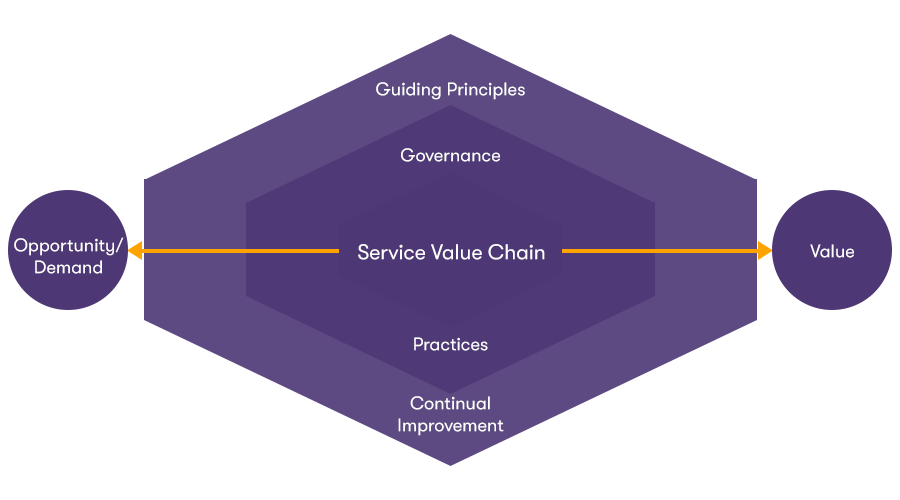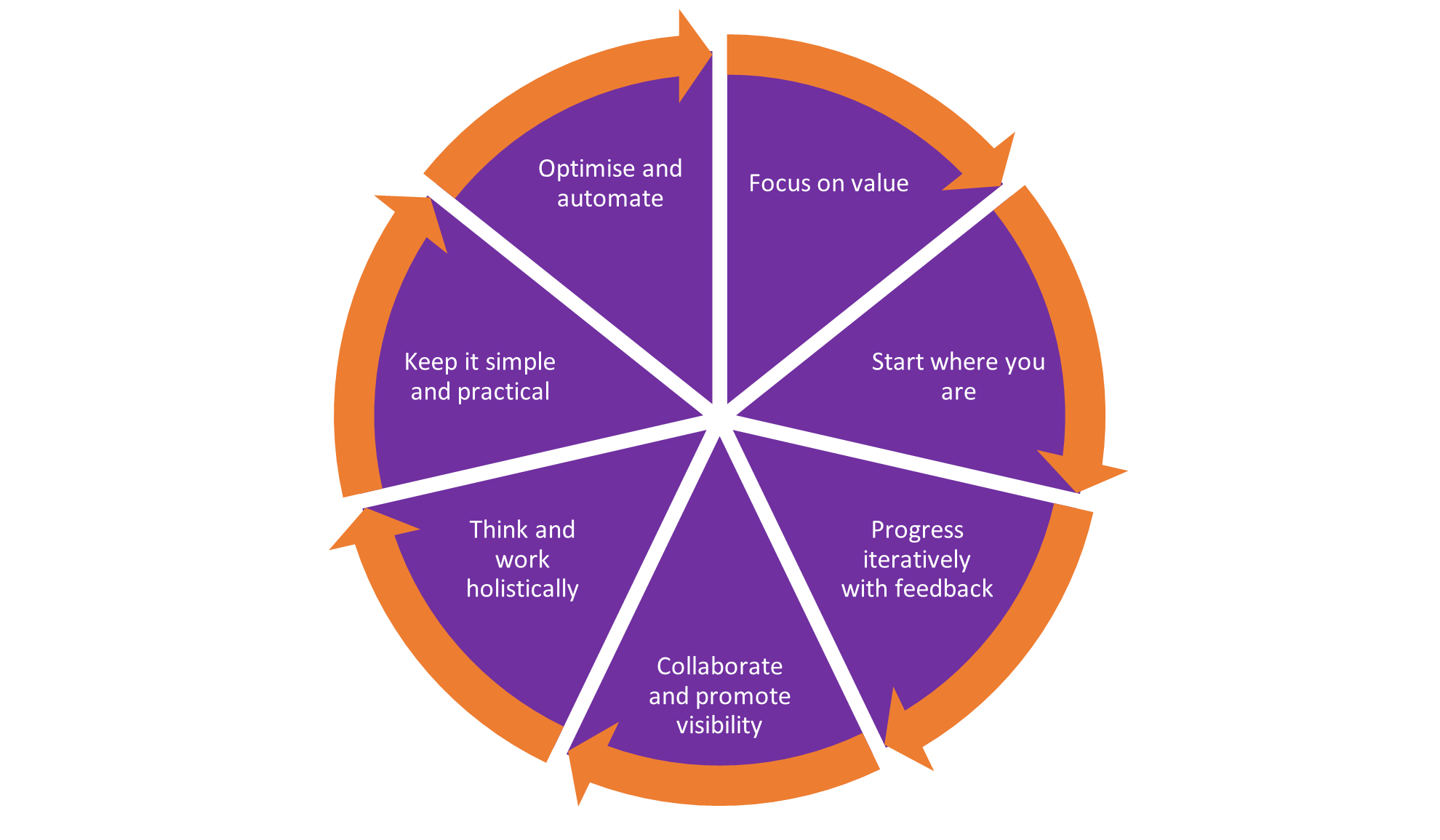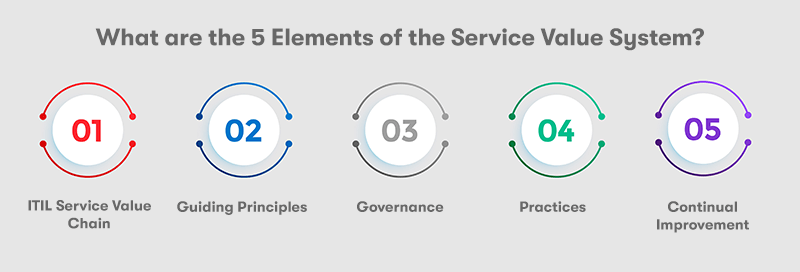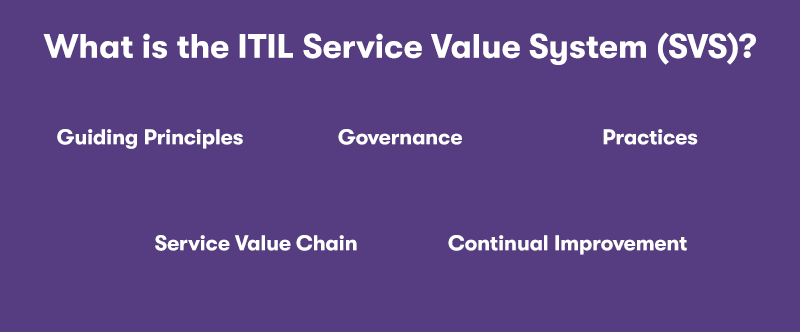What is the ITIL Service Value System (SVS)?
Welcome to our exploration of the ITIL Service Value System (SVS), a cornerstone of the ITIL 4 framework that revolutionises the way organisations think about and manage service delivery. At the heart of ITIL 4, the SVS presents a comprehensive and flexible model designed to facilitate value creation through effective service management. This system integrates various components, including the Service Value Chain (SVC), guiding principles, governance, practices, and continual improvement, to ensure a holistic approach to delivering services that meet customer needs and business objectives. As businesses face ever-evolving challenges and opportunities in the digital age, understanding the SVS becomes crucial for aligning IT services with strategic goals, optimising processes, and enhancing customer satisfaction.
Join us as we delve into the intricacies of the SVS and its pivotal role in modern service management.
What is the Service Value System in ITIL 4?

The Service Value System (SVS) is a core component of ITIL 4, which represents a holistic approach to service management, aiming to ensure that organisations can adapt to change, meet customer needs, and deliver value effectively. The ITIL 4 SVS is built around the concept that all the components and activities of an organisation should work together as a system to enable value creation. It encompasses the following elements:
Guiding Principles
These are recommendations that guide an organisation in all circumstances, regardless of changes in its goals, strategies, type of work, or management structure. The guiding principles include focusing on value, starting where you are, progressing iteratively with feedback, collaborating and promoting visibility, thinking and working holistically, keeping it simple and practical, and optimising and automating.
Governance
This component ensures an organisation's policies and guidelines are aligned and maintained across all activities of the service value system. It includes directing, controlling, and evaluating an organisation's processes and practices to ensure they are appropriately managed and can achieve the desired outcomes.
Service Value Chain (SVC)
At the heart of the SVS is the Service Value Chain, a set of interconnected activities that an organisation performs to deliver a valuable service or product to its customers and stakeholders. The SVC is flexible and allows for various approaches to define value streams. The six key activities of the SVC are Plan, Improve, Engage, Design & Transition, Obtain/Build, and Deliver & Support.
Practices
ITIL 4 introduces the concept of practices, which are sets of organisational resources designed for performing work or accomplishing an objective. The practices combine the resources, people, information, and technology necessary to manage and deliver services. There are 34 practices in ITIL 4, categorised into three types: general management practices, service management practices, and technical management practices.
Continual Improvement
This element emphasises the need for organisations to seek ways to improve service management and delivery continuously. It includes the ITIL continual improvement model, which provides a structured approach to identifying and implementing improvements.
The SVS framework is designed to be adaptable, allowing organisations to tailor their service management efforts to their specific needs, challenges, and the ever-changing business environment. By integrating these components, the ITIL 4 SVS helps organisations navigate the complexities of modern service delivery, ensuring that they can create, deliver, and continuously improve their services in alignment with their strategic goals.
(To Learn more about ITIL SVS, check out our ITIL Foundation Course)
Why is it Important to Have a Service Value System?

Having a Service Value System (SVS) in place, as outlined in ITIL 4, is crucial for organisations for several reasons. It serves as the backbone of service management, ensuring that services are aligned with the business's strategic objectives and are capable of delivering real value to both the organisation and its customers. Here are the key reasons why an SVS is important:
Ensures a Holistic Approach
The SVS encourages organisations to take a holistic view of service management. It integrates various components such as guiding principles, governance, service value chain, practices, and continual improvement into a unified system. This approach ensures that all aspects of service delivery are considered and managed cohesively, leading to more effective and efficient service management practices.
Aligns Services with Business Strategy
By focusing on value creation and delivery through its guiding principles and governance, the SVS ensures that all service management activities are directly aligned with the business's strategic objectives. This alignment helps organisations to prioritise initiatives that deliver the most value and to adapt their strategies in response to changing business environments.
Facilitates Adaptability and Flexibility
The ITIL 4 SVS is designed to be adaptable, allowing organisations to tailor their service management practices to their specific needs, challenges, and the dynamic nature of the business landscape. This flexibility ensures that organisations respond quickly to market changes, customer needs, and technological advancements.
Improves Service Quality and Efficiency
Through the application of practices and a focus on continual improvement, the SVS helps organisations enhance the quality of their services while optimising resources and processes. This leads to improved efficiency, reduced costs, and higher customer satisfaction.
Enhances Customer Satisfaction
By ensuring that services are designed and delivered with a focus on value, the SVS helps organisations to better meet customer needs and expectations. This focus on delivering valuable outcomes leads to improved customer satisfaction and loyalty, which is critical for long-term success.
Supports Continual Improvement
The inclusion of continual improvement as a core component of the SVS emphasises the importance of ongoing evaluation and enhancement of service management practices. This ensures that organisations remain competitive and can continuously adapt and improve their services and processes over time.
Fosters Collaboration and Visibility
The SVS promotes collaboration among different parts of the organisation and enhances visibility across the service value chain. This collaboration and transparency are essential for identifying opportunities for improvement, managing risks, and ensuring everyone is aligned with the organisation's goals and objectives.
Overall, the Service Value System is fundamental for organisations aiming to manage and deliver services effectively in today's complex and rapidly changing business environment. It provides a comprehensive framework that not only supports the delivery of services but also ensures that these services continually evolve to meet the demands of the business and its customers.
What are the Guiding Principles of the ITIL Service Value System?

The ITIL Service Value System incorporates seven guiding principles designed to guide organisations in their decision-making and approaches to service management, regardless of their specific goals, organisational type, or management strategy. These principles are applicable to nearly any initiative or aspect of service management. Here's a brief overview of each:
Focus on Value
Every decision and action should contribute to value creation for stakeholders. Organisations need to understand what is valuable to their customers and stakeholders and focus their efforts on delivering that value.
Start Where You are
Before making any changes, assessing and considering what is currently working and what isn't within the existing organisation's processes and capabilities is essential. This principle advises against reinventing the wheel when existing elements can be utilised or improved.
Progress Iteratively with Feedback
Significant changes can be overwhelming and challenging to manage. This principle suggests making incremental improvements, allowing for adjustments based on feedback at each stage. This approach helps to manage risk and ensures that changes are more manageable and effective.
Collaborate and Promote Visibility
Collaboration across teams and transparency of work and decisions are crucial for success. This principle emphasises the importance of breaking down silos, encouraging teamwork, and making information and processes visible and accessible to those who need them.
Think and Work Holistically
No service, process, or component should be considered in isolation. Organisations should ensure that all aspects of the service value system are considered and integrated to deliver a cohesive and effective service management approach.
Keep It Simple and Practical
This principle advises focusing on simplicity and practicality. Efforts should be concentrated on what's absolutely necessary to deliver value, avoiding overcomplication or unnecessary work that doesn't contribute to the goals.
Optimise and Automate
Organisations should always look for ways to improve and streamline processes before considering automation. This principle suggests that manual processes should be optimised to ensure they are as efficient as possible, and only then should automation be applied to maximise efficiency and effectiveness.
These guiding principles form the backbone of the ITIL SVS framework, providing a flexible and adaptable approach to service management that can be applied to a wide range of organisational contexts. They encourage a culture of continuous improvement, customer focus, and efficient service delivery, all of which are essential for creating and maximising value in the modern business environment.
What is the Service Value Chain?
The Service Value Chain is a fundamental concept within the ITIL 4 framework, representing a flexible and versatile model for creating, delivering, and improving services. It provides an operating model for service providers to transform inputs (opportunities and demands) into valuable customer outputs (services). The SVC comprises six interconnected activities that facilitate value creation through service management. These activities are:
Plan
This activity involves defining policies, objectives, and guidelines for the organisation's overall direction. It ensures a shared understanding of the organisation's vision, current status, and improvement direction.
Improve
Focused on continually improving services, practices, and processes across all value chain activities. It involves identifying and implementing improvements to ensure the organisation's services meet evolving business needs.
Engage
Interacting with stakeholders to understand their needs and ensure that the service provider is effectively meeting those needs. This includes providing information about services, capturing feedback and requirements, and managing relationships.
Design & Transition
This activity ensures that new or changed services meet stakeholder expectations and can be delivered effectively. It covers the steps from the design of services to their transition into the live environment, ensuring that services are designed for value, feasibility, and usability.
Obtain/Build
Deals with the acquisition or creation of the components needed for the delivery of services. This could include obtaining physical resources, infrastructure, or knowledge and developing software or other service components.
Deliver & Support
Focuses on the actual delivery and support of services to customers, ensuring that services are delivered as agreed and that ongoing support is provided to resolve issues and fulfil user requests.
These six activities are not linear but are interlinked and can be combined in various ways to form multiple value streams. A value stream is a specific set of activities that create and deliver a particular service or product to customers. The flexibility of the SVC allows organisations to tailor their approach to service management according to their specific needs, strategies, and customer demands.
The Service Value Chain emphasises the importance of viewing service management as a dynamic system where different parts work together to facilitate value creation through services. It provides a comprehensive, adaptable framework for service providers to ensure they can effectively manage and improve their services in alignment with business goals and customer needs.
What are the 5 Elements of the Service Value System?

The ITIL 4 framework introduces the concept of the Service Value System, which is designed to provide a comprehensive approach to service management. The SVS ensures that organisations can effectively facilitate value creation through the management of products, services, and relationships. It consists of five main components that work together to enable this value-creation process:
ITIL Service Value Chain
At the heart of the SVS, the Service Value Chain is a flexible model consisting of six key activities (Plan, Improve, Engage, Design & Transition, Obtain/Build, and Deliver & Support) that operate together to create and manage value through service delivery. This model allows organisations to transform inputs (demands and opportunities) into valuable outputs (services) for their customers.
Guiding Principles
These are recommendations that can guide an organisation in all circumstances, regardless of changes in its goals, strategies, type of work, or management structure. The guiding principles include focusing on value, starting where you are, progressing iteratively with feedback, collaborating and promoting visibility, thinking and working holistically, keeping it simple and practical, and optimising and automating.
Governance
Governance within the SVS ensures a clear direction and control for the organisation, guiding the management and operation of its information technology. It ensures that the organisation's strategy is reflected in its service delivery and that its operations align with its overall goals and regulations.
Practices
In ITIL 4, practices are sets of organisational resources designed for performing work or accomplishing an objective. These practices include general management practices, service management practices, and technical management practices. They provide a comprehensive and versatile toolset for managing and delivering services.
Continual Improvement
This component is integrated throughout all elements of the SVS, emphasising the need for ongoing evaluation and enhancement of services, practices, and processes. The continual improvement model provides a structured approach to identifying and implementing improvements, ensuring the organisation remains competitive and responsive to changing business needs.
These five elements of the Service Value System are interconnected and work together to enable organisations to efficiently and effectively manage their services, ensuring they can adapt to change, meet customer needs, and deliver value in a dynamic business environment.
SVC vs SVS What's the Difference?

The difference between the Service Value Chain and the Service Value System in ITIL 4 lies in their scope and function within the framework of service management. Both are essential concepts within ITIL 4, but they serve different purposes and encompass different aspects of service management. Here's a breakdown of the differences:
Service Value Chain
Focus: The SVC is a specific component within the SVS, focusing on the activities and operations involved in the delivery of services. It is essentially an operating model that outlines the key actions required to respond to demand and facilitate value creation through service management.
Components: The SVC comprises six key activities: Plan, Improve, Engage, Design & Transition, Obtain/Build, and Deliver & Support. These activities are interconnected and can be combined in various ways to create value streams that define specific paths for delivering services to customers.
Function: Its primary function describes how different parts of an organisation work together to create, deliver, and support services. It emphasises flexibility and adaptability, allowing organisations to tailor their approach to service management according to their specific needs and customer demands.
Service Value System
Focus: The SVS represents the entire organisational model, enabling value creation through service management. It provides a comprehensive framework that encompasses all the components and activities necessary for the management and delivery of services.
Components: The SVS includes the Service Value Chain, Guiding Principles, Governance, Practices, and Continual Improvement. These elements work together to ensure that an organisation can effectively facilitate value creation for its stakeholders.
Function: The SVS outlines the overall approach to service management, ensuring that every aspect of the organisation's service delivery is aligned with its strategic objectives. It integrates principles, governance, practices, and continual improvement to manage resources, optimise processes, and adapt to changes in the business environment.
Summary of Differences
Scope: The SVC is a component of the SVS, focusing specifically on the operational aspects of service delivery. On the other hand, the SVS is the overarching framework that includes the SVC among its elements, providing a holistic approach to service management.
Purpose: The SVC details the operational model for creating and managing services, while the SVS defines the overall system that an organisation uses to ensure effective service management and value creation.
Components: While the SVC is centred around the six key activities for service delivery, the SVS encompasses these activities within a broader system that also includes guiding principles, governance, practices, and continual improvement.
In summary, while the SVC provides the model for operational activities in service management, the SVS offers the overarching framework that integrates these activities with guiding principles, governance, practices, and continual improvement to enable comprehensive and effective service management.
Final Notes on the ITIL 4 Service Value System
In conclusion, the ITIL 4 framework introduces a comprehensive approach to service management through its Service Value System and the integral Service Value Chain. The SVS offers a holistic framework, incorporating guiding principles, governance, practices, and continual improvement, ensuring that organisations can effectively facilitate value creation.
Within this system, the SVC operates as a flexible model detailing key activities essential for service delivery. Understanding the distinction between SVC and SVS is crucial for organisations aiming to implement ITIL 4 effectively, as it enables a clear grasp of both the overarching framework and the operational activities within.
This knowledge ensures that businesses can adapt to change, meet customer needs, and deliver value efficiently, fostering a culture of continuous improvement and strategic alignment in service management.


